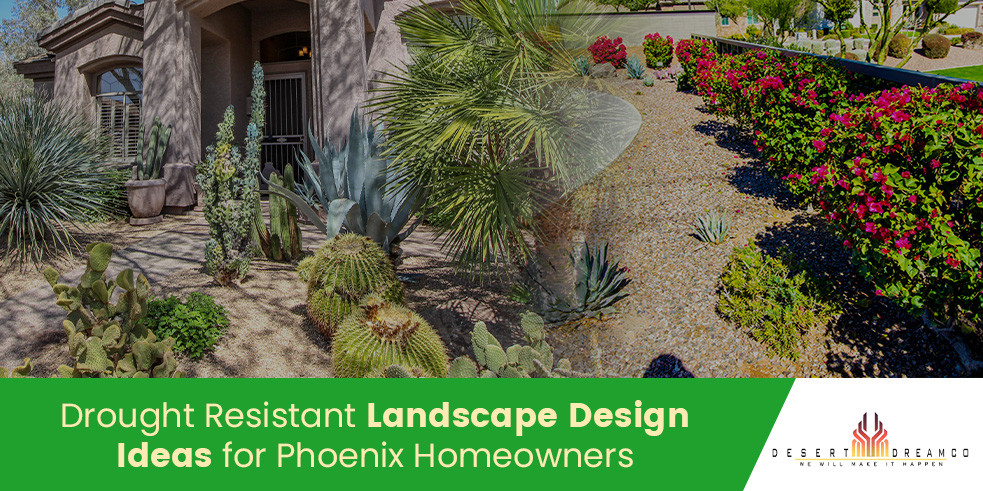Drought Resistant Landscape Design Ideas for Phoenix Homeowners
Arizona has been in a drought for decades.
Landscaping typically uses a ton of water, there are plenty of landscape design ideas for an aesthetically-pleasing, drought-tolerant landscape that can help your pocketbook and the environment at the same time.
So which landscape design ideas can minimize your water bills?
How can they make your backyard or front yard look stunning?
Keep reading to learn more.
Afterward, you’ll be ready to hire the services of a professional landscape designer.
Rock-Soil Yards
Conventional grass yards use a lot of water, needing about 1-1.5 inches of water each week — even more in drier climates.
Each inch requires a little over half a gallon of water per square foot.
This upkeep places a lot of burden on the environment, your utility bills, and in some cases, your time.
But unlike conventional grass yards, rock-soil yards don’t need any water.
It also doesn’t attract pests, withstands heavy foot traffic, and can improve drainage.
They’re also more versatile to customize, with landscapers varying rock size and type to add texture the design.
All this, without the responsibility of keeping your yard alive.
Converting your yard into a rock-soil yard can positively transform your landscape and minimize your daily outdoors task list.
Sized Down Landscape
Landscapes that are too big are heavy on the wallet, local water supply, and your schedule.
Not only is there more yard to maintain, but you have to pay more for a bigger landscape.
So rethink your landscape design.
Do you really need to transform and maintain every inch of your backyard?
Are you able to sit back and regularly admire every plant flower bed you plant?
If your answers to these questions indicate any doubt, size down your landscape.
Or, at the very least, minimize the amount of organic material you add to your landscape.
Succulent Garden
There are plenty of gorgeous flowers to plant, so why choose those that use a lot of water?
More delicate watering conditions might also come saddled with other complicated growing requirements.
It’s best to avoid these disadvantages by opting for drought-tolerant gardens.
Of course, water-retaining plants such as cacti and succulents are incredible drought-resistant options.
There are other drought-resistant plants, but succulent gardens can showcase a colorful variety with their uniquely thick, fleshy leaves.
So go for the popular tree houseleek, pigmyweed, and haworthia.
If you want to set your garden apart from others, use hanging strings of turtles and red-tipped calico hearts!
As with all landscaping designs, successful setups aren’t just about the material.
It’s also about strategy., so make sure you mix and match textures and colors to wow any spectating plant-lovers, including yourself.
Amended Soil
Amended soil is exactly what it sounds like — soil that’s been fixed and improved.
Keep in mind that it’s also different from simply changing out your soil since that function primarily resolves around replenishing soil’s nutritional content.
Homeowners can boost their soil’s water retention, drainage, and water infiltration abilities by amending their soil.
In other words, it can better absorb water and hold onto water a lot longer.
So it’s good to inspect your soil if your plants look constantly sickly.
However, this can only be done by a local soil specialist.
Hardscape Elements
As mentioned before, organic material can tick up your landscape’s water usage.
But why does every landscape feature need to centralize flowers and shrubbery?
Hardscape elements include walkways, arbors, stone benches, swimming pools, and driveways.
So next time you look at your yard, ask yourself whether you want a new way to enjoy your backyard.
Then, you might find yourself drawing up a blueprint for a new patio.
These elements will be built over outdoor areas, minimizing space for grass to spread or weeds to pluck out.
Even better, pick porous building materials to construct these elements.
This way, they’ll absorb water which your entire landscape can use for supplemental moisture.
Moss
When your landscape can’t retain water, moisture evaporates more quickly.
Your plants will dry out faster and not have enough water to absorb.
But moss can improve water retention.
When strategically placed, it will readily absorb water and prevent it from evaporating quickly.
That way, water stays in the soil for longer, improving the reliability of your garden’s water supply.
Not only that, but it looks soft and woodsy.
This can provide an ethereal bent that most other drought-tolerant options don’t.
They’re also versatile and easy to incorporate, with homeowners placing them around walkways, water features, and their garden’s grounds.
It would be best to use drought-resistant moss, such as fern moss.
Otherwise, you will just have another water-thirsty burden.
Rain Collection
Did you know that every inch of rain that falls onto a 1,000-square-foot yard produces about 600 gallons of rainwater?
So even if it doesn’t often rain in your area, it’s a great idea to collect rainwater when it comes.
When rainwater fills your barrels and containers to the brim, you’ll be able to water your plants with it.
Doesn’t that sound better than letting perfectly good, usable rainwater evaporate?
Landscape Design Ideas for a Stunning Home
With this drought-tolerant landscape design guide, homeowners can enjoy a stunning, lush view in the comfort of their own backyards.
So let these landscape design ideas amp up your landscape’s drought tolerance and aesthetic scheme!
At Desert Dream Co, we know what the best landscape design looks like.
For that reason, we offer some of the best landscaping services in Arizona!
Contact us today to get started.
Are you looking for drought resistant landscape design company? Contact Desert Dreamco, a 5-star, family-owned business with years of experience helping Arizona homeowners with landscape and hardscape construction services. Call (623) 226-0192 or schedule a free consultation online.
Read Related Blogs:


